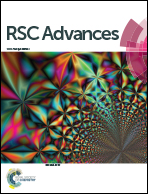Synthesis and thermal stability of ZrO2@SiO2 core–shell submicron particles†
Abstract
ZrO2@SiO2 core–shell submicron particles are promising candidates for the development of advanced optical materials. Here, submicron zirconia particles were synthesized using a modified sol–gel method and pre-calcined at 400 °C. Silica shells were grown on these particles (average size: ∼270 nm) with well-defined thicknesses (26 to 61 nm) using a seeded-growth Stöber approach. To study the thermal stability of bare ZrO2 cores and ZrO2@SiO2 core–shell particles they were calcined at 450 to 1200 °C. After heat treatments, the particles were characterized by SEM, TEM, STEM, cross-sectional EDX mapping, and XRD. The non-encapsulated, bare ZrO2 particles predominantly transitioned to the tetragonal phase after pre-calcination at 400 °C. Increasing the temperature to 600 °C transformed them to monoclinic. Finally, grain coarsening destroyed the spheroidal particle shape after heating to 800 °C. In striking contrast, SiO2-encapsulation significantly inhibited grain growth and the t → m transition progressed considerably only after heating to 1000 °C, whereupon the particle shape, with a smooth silica shell, remained stable. Particle disintegration was observed after heating to 1200 °C. Thus, ZrO2@SiO2 core–shell particles are suited for high-temperature applications up to ∼1000 °C. Different mechanisms are considered to explain the markedly enhanced stability of ZrO2@SiO2 core–shell particles.



 Please wait while we load your content...
Please wait while we load your content...